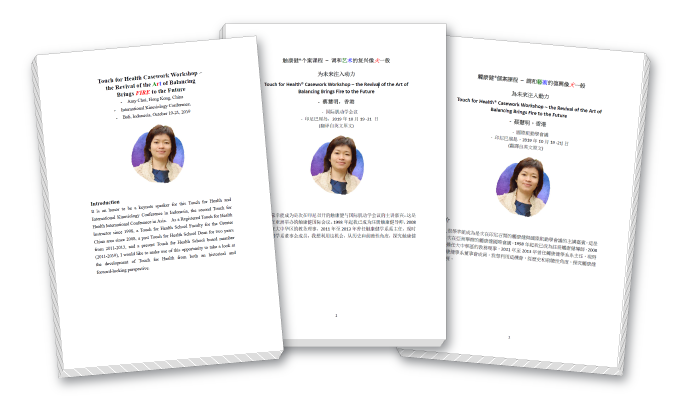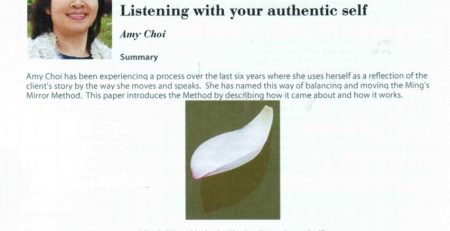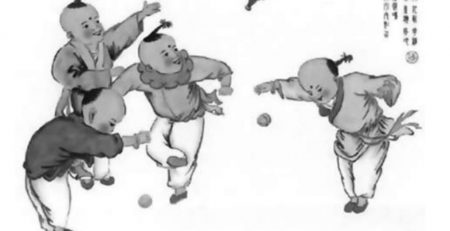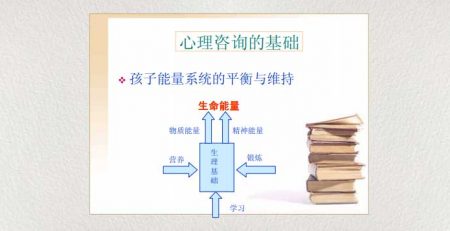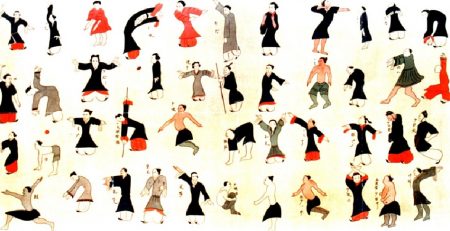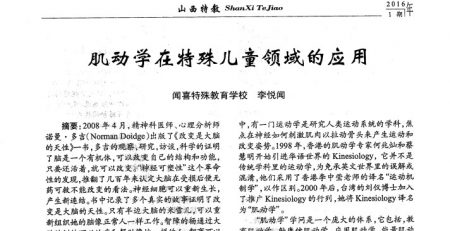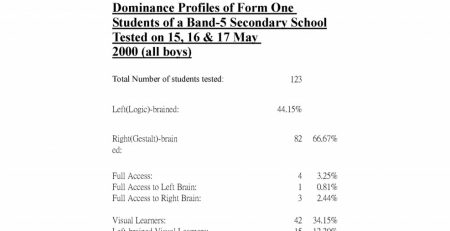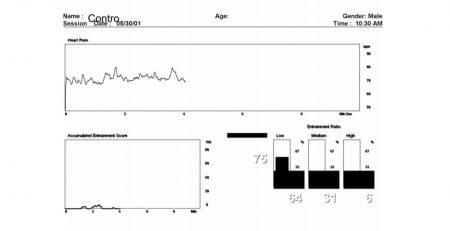Touch for Health Casework Workshop – the Revival of Art of Balanceing Brings FIRE to the Future
Brings FIRE to the Future
Touch for Health® Casework Workshop the Revival of the Art of Balancing Brings Fire to the Future
– Amy Choi, Hong Kong, China
– International Kinesiology Conference
– Bali, Indonesia, October 19-21,2019
Introduction
It is an honor to be a keynote speaker for this Touch for Health and International Kinesiology Conference in Indonesia, the second Touch for Health International Conference in Asia. As a Registered Touch for Health Instructor since 1998, a Touch for Health School Faculty for the Greater China area since 2008, a past Touch for Health School Dean for two years from 2011-2013, and a present Touch for Health School board member (2011-2019), I would like to make use of this opportunity to take a look at the development of Touch for Health from both an historical and forward-looking perspective.
Touch for Health John and Carrie Thie’s Style
Many of us who had the privilege of learning Touch for Health from the founder Dr. John Thie may remember his vision and passion for promoting Touch for Health. He envisioned Touch for Health to be used in every family as a self-help tool for remembering wellness. I first learnt Touch for Health from John from his 6-day Touch for Health Seminar in Malibu, California, U.S.A. in 1997. It was a class with an attendance of 8 people. The book Touch for Health authored by him (often referred to as the “Red book”) was used as the class manual. Towards the end of the book he says, “Dr. Thie travels worldwide, giving training on his methods of using Touch for Health to enhance performance and help people reach their personal goals.” It was clear to me even after taking his Touch for Health 6-day seminar, that was the intention of his sharing Touch for Health to the world.
He taught in Touch for Health in a casework-oriented way. He used client interviewing and goal-setting techniques, plus all ways he used Touch for Health to do balances for clients in a chiropractic clinic. “14-muslce-fix-as-you-go” was his most favorite technique. Students observed how he did balances and then practiced with each other. Rather than what some people describe as “clinical”, I would like to comment that back then, I remembered Touch for Health as being taught in a holistic, artistic way of balancing that brought out awareness of the person and his/her spirit. Students got the overall and general idea and experiences of what Touch for Health balances could do, though they might not remember all the steps instantly.
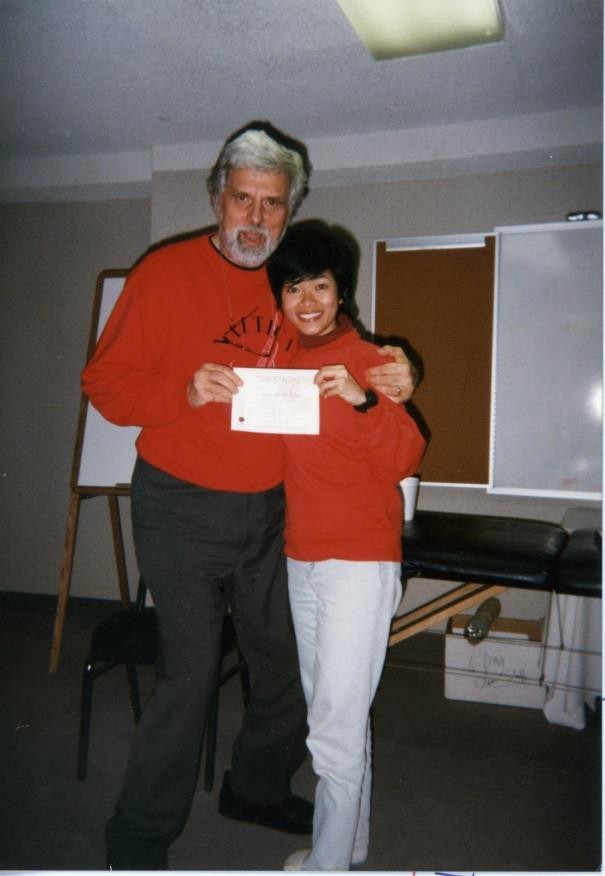
In six days, we learned the 14, 14+, and 42 muscles standing up and lying down tests, all the correction techniques. We also learnt one-point balances and other types of applications. We learnt goal-setting and how to do Touch for Health balances while observing the teacher. A handout on Touch for Health Metaphor was being distributed. Some ideas and concepts of the Chinese five-element metaphors and how to apply them for Touch for Health balancing were used and taught. His wife Carrie Thie was a co-teacher who delivered the part on effective personal communications. Major contributors to practical ways of productive inter-personal communication such as Dr. Carl Rogers, Thomas Gordon and Dr. Virginia Satir were referred to. Active listening and major counseling skills used in Touch for Health education balancing, observing and tracking process were taught.
From the handout Touch for Health Tree Synthesis copyrighted 1992 by the TH Enterprise Catalog distributed to every student, Touch for Health by Dr. John Thie was depicted in the middle of the major tree trunk. The President of IASK (International Association of Specialized Kinesiologists) Jim Reid’s quote in April 5, 1989 says “We further acknowledge that Touch for Health is the Foundation upon which ALL Specialized Kinesiology is built.” Touch for Health Synthesis, depicted in one of the tree branches, was said to be “Foundation of All Specialized Kinesiologies, alive and growing – the more you know the less you will use. Keep learning!”
John Thie then advised me to take Touch for Health Instructor Training Workshop (ITW) from Toni Gralton (Lilley) from Australia who was then the Touch for Health School Dean of International Kinesiology College Ltd. (IKC). In autumn 1998, I went to Sydney to take ITW from Toni, who then had published her official English manuals for Touch for Health Synthesis – Levels I to IV. (the Synthesis) .
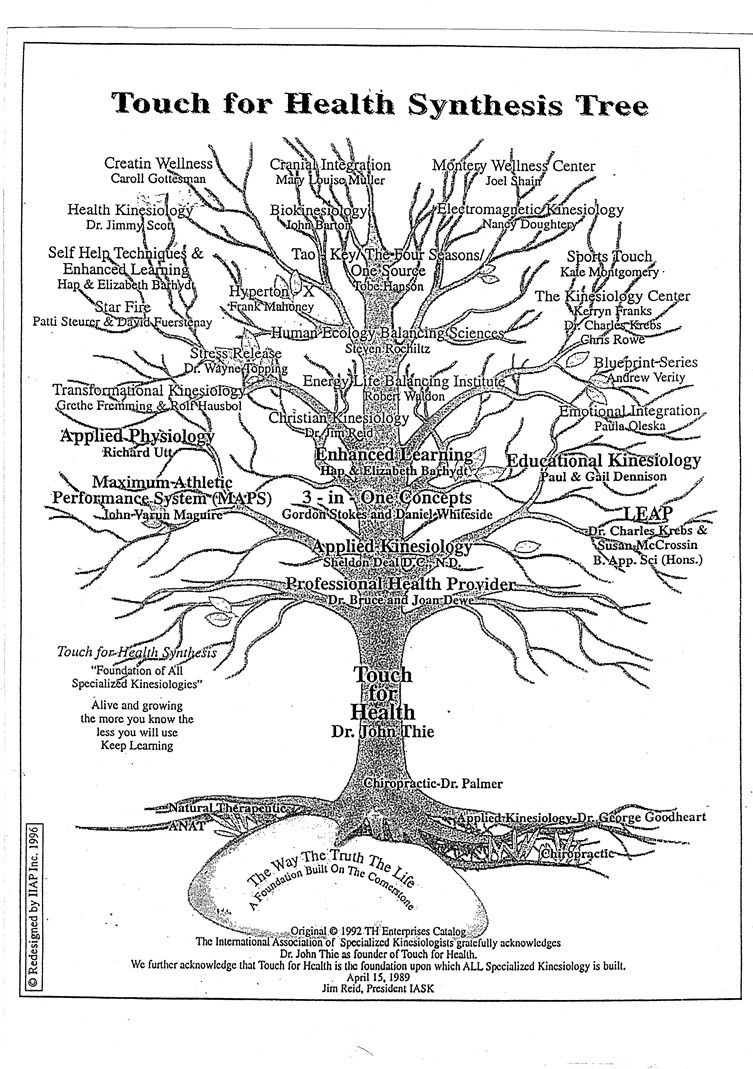
Touch for Health Synthesis and Touch for Health Proficiency
Over years of teaching, I came to realize that Touch for Health Synthesis had chunked down Touch for Health techniques into steps that were easy to follow. Each level of the Synthesis has its specific learning outcome, curriculum and syllabus. Instructors-to-be are trained to teach the Synthesis technique-by-technique, step-by-step. Touch for Health taught in the Synthesis way were then believed to make it effective and manageable for Touch for Health Instructors to teach the techniques for students to learn. In addition to the Touch for Health Synthesis, Touch for Health Proficiency (the Proficiency) was later developed with written, oral and practical assessments for Touch for Health. It was believed that the Proficiency would provide better-quality instructors and might enable Touch for Health Synthesis to satisfy health industry, government regulatory or insurance company standards.
With the author of Touch for Health Synthesis Ms. Toni Lilley being the Touch for Health School Dean of IKC for 15 years, the IKC-recognized TFH Synthesis way of communicating and teaching Touch for Health has became the official version of Touch for Health that is most widely taught around the world.
Touch for Health Complete Edition and the Clinical Touch for Health
The book Touch for Health Complete Edition (the Complete Edition) by John Thie and his son Matthew Thie was published in 2005, the same year before the founder was diseased. Matthew became a Touch for Health Faculty and later on the Complete Edition also became recognized by the IKC as an official version for teaching Touch for Health Synthesis. The Complete Edition, being a book and not a course manual, has been mostly being used by instructors in the U.S. and some English-speaking areas for teaching the Synthesis, and by Matthew Thie, for teaching his “Clinical Touch for Health” workshop. I have co-sponsored Matthew’s Clinical Touch for Health in Beijing in 2009. The workshop left me with the impression that it managed to deliver Touch for Health in a “clinical” way, with Touch for Health metaphors, similar to how the founder did it himself. However, neither the Clinical Touch for Health nor any shorter versions of the Touch for Health Clinical workshops developed by the John and Matthew are carried by the Touch for Health School of the IKC as official workshops of the School.
Touch for Health Casework Workshop
Knowing the learning needs of the students in my country, having experienced the development of Touch for Health in Asia, and having looked and world trends as a TFH School administrator, Touch for Health School Trainer Conrad Ho (Conrad) and myself decided to take a second look at the Touch for Health Synthesis and develop a teaching model that aims to revive the artistic and holistic way of Touch for Health teaching and learning. In early 2012, we developed the Touch for Health Casework Workshop.
What is the Touch for Health Casework Workshop About?
- Communicating TFH
- “Coming back to the basic”
- Encouraging people to use TFH in their daily lives
- Finding new ways to market TFH
- Finding new ways to teach TFH
- Growing TFH in developing areas where there is few other kinesiologies
- Part of the TFH Consultant programme in China
- Benefits in addition to Techniques
- Whole to parts in addition to Part to whole
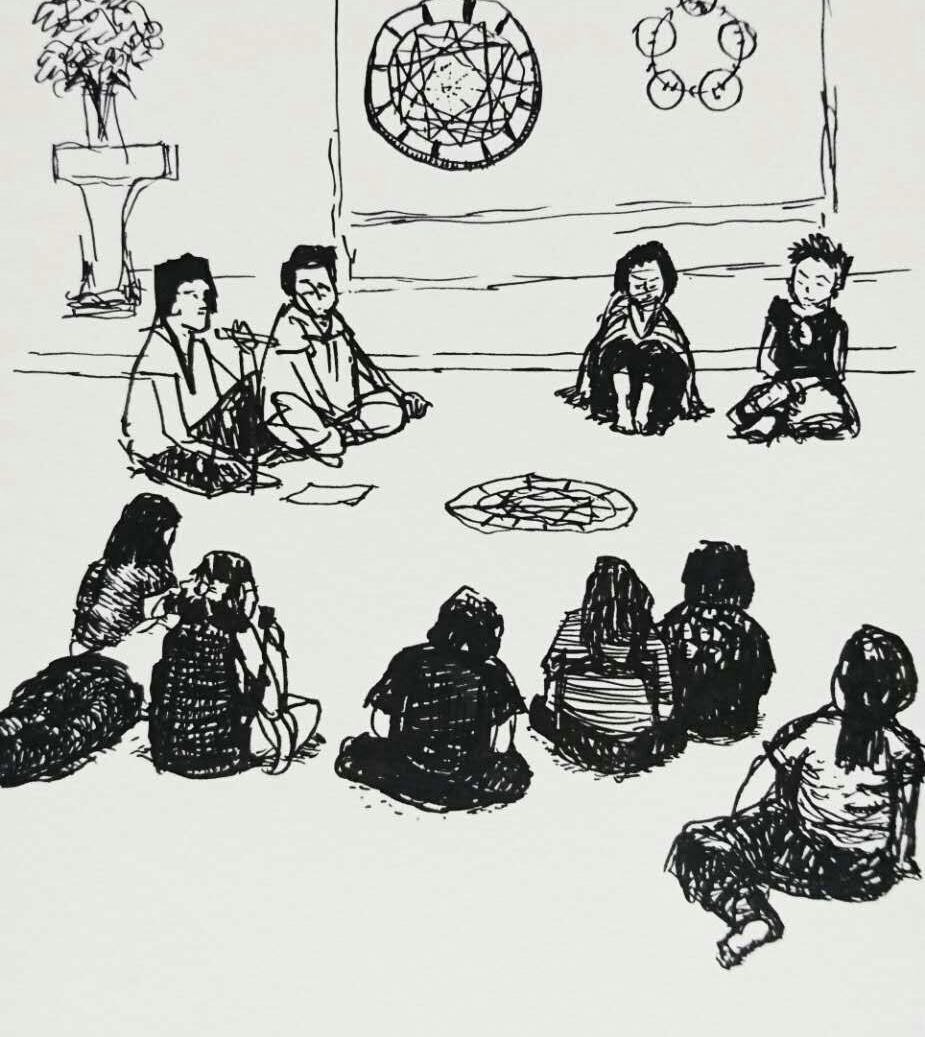
Touch for Health Casework Workshop Helps People Answer these Questions:
- What is the use of Touch for Health?
- What benefit will I get from Touch for Health?
- Is Touch for Health easy to learn?
- Is Touch for Health simple to use?
Course Objectives of Touch for Health Casework Workshop:
- To deliver TFH in its daily life, casework applications
- To manifest TFH as a balancing art
- To deliver TFH balances with the main objective of helping the clients in improving his/her wellness
- To express an overall view of TFHS and offer a structure for all the balances in TFHS
- To offer in-depth observation and practice on goal-setting and remember wellness
- To offer a step in the training of the internationally recognized TFH Consultant programme
Target participants of the Touch for Health Casework Workshop:
- Those interested in TFH and kinesiology
- Those interested in becoming an internationally-recognized TFH Consultant
- Those interested in improving his/her mind-body wellness
- Those interested in learning and deepening TFH techniques in casework settings
- Medical, para-medical and health-care professionals
- Counsellors
- Care-takers
- Trainers
- TCM doctors, life-care or related professionals
- Sports coach, dancer, athletes
- Those who have issues in mind, and would like to balance for physical or psychological blocks and challenges
Who can teach Touch for Health Casework Workshop in the Greater China area?
- For now: – Faculty, Trainer
- For the future: – TFH Trainers who have participated in TFH Casework Workshop once, and had co-taught the TFH Casework once
Touch for Health Balancing Options Overview:
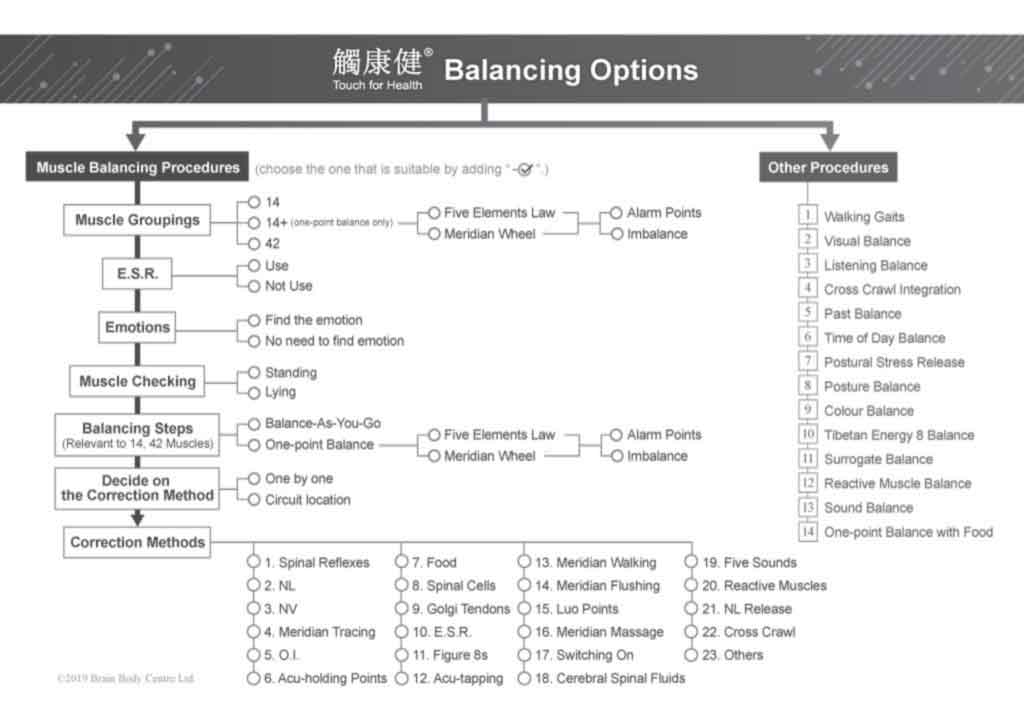
Workshop Outline
The 8-10 day workshop was divided into 2 halves – 5 days for each section.
A total of 23 balances are demonstrated and practiced, on an average of 3 balances per day, covering all balancing types in the Touch for Health Synthesis. They are:
- 14 muscle balance-as-you-go (standing) – use correction point one after another, with challenge
- 42 muscles balance-as-you-go (standing) – use circuit location, with challenge
- 42 muscles balance-as-you-go (lying) – use circuit location, with challenge
- 14+ muscle one-point balance (meridian wheel) – no alarm points, standing tests
- 14+ muscle one-point balance (five-element chart) – no alarm points, standing tests
- 14+ muscle one-point balances (meridian wheel) – with alarm points, lying down tests
- 14+ muscle one-point balance (five-element chart) – with alarm points, lying down tests
- Walking gaits balances
- Visual inhibition balances
- Auricular exercise
- Figure 8 balance
- Meridian walking for chronic pain
- Cross-crawl integration exercises
- Postural stress release
- Reactive Muscle balances
- Colour balances
- Surrogate balances
- Pain Tapping for chronic pain
- Time of day balance
- Past balancing
- Postural balance
- Sound balance
- Food balance
The first experiment was conducted in December 15-19, 2012 and October 2-6, 2013 in Dalian, China. There were 7 students for each class. The second one was conducted in Shenzhen, China, in from October 15-19, 2016 for 24 students; and November 12-16, 2016 for 27 students. The third class was conducted in Zhengzhou and Dengfeng, China on May 16-20, 2018 for 9 students, and on December 5-9, 2018 for 13 students. Thus, there were 87 students in total who have attended the workshop over a period of 6 years.
Survey Statistics 2016
The workshops were designed to welcome Touch for Health Instructors, Touch for Health Synthesis students and new comers. Student surveys were done in 2016 and 2018. Here’re the statistics results:
In 2016, 11 Registered Touch for Health Instructors and 10 Touch for Health students handed in their questionnaire. Out of the 11 instructors, percentage with 1-2 years of experiences – 63.60%, 2-10 years – 18.20%, 10 years or above 18.20%. Out of the 10 Touch for Health students, 20% have attended Touch for Health Synthesis Levels 1 to 2, 80% have attended all four levels.
Analysis of the statistics gathered from Touch for Health Instructors in 2016:
- 100% of them thought Touch for Health Casework Workshop helped them better understand Touch for Health Synthesis;
- 100% of them thought Touch for Health Casework Workshop, if carried out continuously, may help the development of Touch for Health in the long run;
- 81.80% of them thought, with proper training, they would like to become an Instructor of the Touch for Health Casework Workshop.
Among these Instructors, 100% of them practice Touch for Health on themselves and in their families regularly.
Analysis of the statistics gathered from Touch for Health students in 2016:
- Among those who completed all 4 levels of Touch for Health Synthesis, 37.50% of them thought they would want to repeat the Touch for Health Synthesis after taking the Touch for Health Casework Workshop. 50% did not answer this question.
- Among those who completed all 4 levels of Touch for Health Synthesis, 100% of them said they use Touch for Health on themselves and their families.
- Among those who have NOT attended or completed all 4 levels of Touch for Health Synthesis, 100% of them thought they either want to sign up for Touch for Health Synthesis or complete the Touch for Health Synthesis Levels that they have not completed.
Among the TFH Instructor and students who responded in 2016:
- 100% of them thought Touch for Health Casework Workshop allowed them to be more confident in applying Touch for Health Synthesis in their daily lives.
- Average degree of satisfaction of the Touch for Health Casework Workshop scored 9.5, 10 being the highest mark.
- Degree of ease of use of the Touch for Health Casework manual scored 9.5, 10 being the highest mark.
Survey Statistics 2018
In 2018, 8 Registered Touch for Health Instructors and 13 Touch for Health students handed in their questionnaire. Out of the 8 instructors, 62.50% of them have become a Touch for Health Instructor for 3 months, 1-3 years of experiences – 25%, 3 years or above – 12.50%. Out of the 13 Touch for Health students, 7.7% have attended Touch for Health Synthesis Level 1, 15.4% for until Level 2, and 76.9% have attended all four levels.
Analysis of the statistics gathered from Touch for Health Instructors in 2018:
- 100% of them thought Touch for Health Casework Workshop helped them better understand Touch for Health Synthesis;
- 100% of them thought Touch for Health Casework Workshop, if carried out continuously, may help the development of Touch for Health in the long run;
- 87.50% of them thought, with proper training, they would like to become an Instructor of the Touch for Health Casework Workshop.
Among these Instructors, 87.50% of them practice Touch for Health on themselves and in their families regularly.
Analysis of the statistics gathered from Touch for Health students in 2018:
- Among those who completed all 4 levels of Touch for Health Synthesis, 40% of them thought they would want to repeat the Touch for Health Synthesis after taking the Touch for Health Casework Workshop. 30% did not answer this question. 30% said they have not planned for it.
- Among those who completed all 4 levels of Touch for Health Synthesis, 100% of them said they use Touch for Health on themselves and their families.
- Among those who have NOT attended or completed all 4 levels of Touch for Health Synthesis, 66.60% of them thought they either want to sign up for Touch for Health Synthesis or complete the Touch for Health Synthesis Levels that they have not completed.
- 100% of them said they would recommend Touch for Health Casework workshop to their friends and family.
Among the TFH Instructor and students who responded:
- 100% of them thought Touch for Health Casework Workshop allowed them to be more confident in applying Touch for Health Synthesis in their daily lives.
- Average degree of satisfaction of the Touch for Health Casework Workshop scored 9.76, 10 being the highest mark.
- Degree of ease of use of the Touch for Health Casework manual scored 9.14, 10 being the highest mark.
- 100% of them said they would recommend Touch for Health Casework workshop to their friends and family.
Conclusion from the above statistics, comments from students and my teaching experiences:
Touch for Health Casework Workshop:
For new comers
- experience the power and depth of TFH in balancing for their daily situations
For those taken TFH Synthesis
- All of the above
- Experience the power of TFH in a global way
- deepen their confidence on using TFH
- Motivated in using TFH in daily lives
For TFH Instructors
- All of the above
- a step to becoming a IKC TFH Consultant
For the instructor of TFH Casework Workshop
- All of the above
- To experience and communicate TFH as a balancing art
Conclusion and Vision
I believe that reviving the art and holistic way of Touch for Health balancing, to teach Touch for Health to enhance performance and help people reach their personal goals will bring FIRE to the development of Touch for Health worldwide on a new level in the future! I invite interested Faculty of Touch for Health to consider adopting this model of teaching for their country as a compliment to the Synthesis, as an option for Touch for Health continuing education, and an option for training Touch for Health consultant. I would encourage Touch for Health students and Instructors to take this workshop for the experience.
Last but not least, let us teach and share Touch for Health with LOVE, like the founder John Thie did!
— THE END —
Amy’s Choi’s contact: info@brainbodycentre.com

